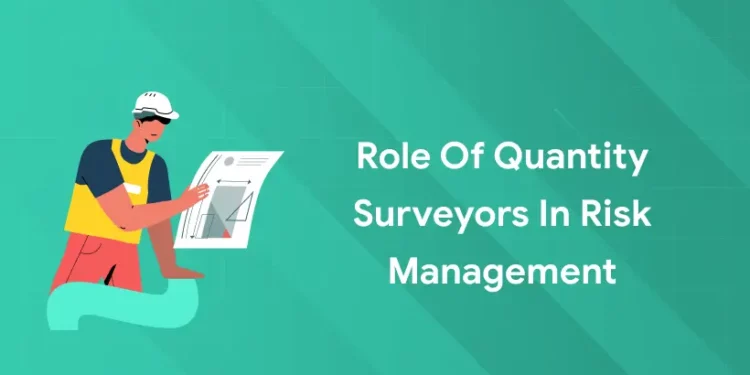Table of Contents
Risk management is a very important aspect of our life. We do this in our daily lives while crossing a road, making decisions, leaving a job for another better one, the examples are many. We do this by the knowledge we gain from previous experience patterns that we had in our life when we or someone we know made similar decisions. Risk is inevitable in any activity and any type of event that may happen in future. And construction industry is not any different. Sir Michael Latham states that no construction is risk-free. He says risk can be managed, minimized, shared, accepted or even transferred. An idea that never ends up with good results is ignoring the risk. But what is the role of quantity surveyors in risk management? Let us read to learn more.
What are the Risks?
A risk in the construction industry can occur due to many things. Some of them are:
- Design flaws
- Unexpected events
- Financial uncertainties
- Inefficient projects management
So, a Quantity Surveyor must always be ready with alternate plans for all possible situations they could think of for the smooth running of the project process.
Join the best quantity surveyor course of the year 2024!
What are the Types of Risks?
1: What is the main purpose of a Bill of Quantities (BoQ)?
It is very important to understand the various types of risks involved in the construction industry. Let us look into some of them.
Known Risks
Some risks are known to experts and are expected to happen when a project begins. Some risks that come under this category are:
- Weather conditions
- Market fluctuations
- Regulatory changes
These types of risks are comparatively easier to handle. They can be managed using appropriate contingency plans and risk allocation mechanisms.
Foreseeable Risks
These types of risks are not anticipated at the beginning of the project. They are not apparent at the starting phase of the project. But they can be identified with the expertise and experience of the professional. These include:
- design conflicts
- subcontractor delays
- resource shortages
When it comes to these types of risks, proactive measures are needed. These need thorough risk assessment procedures as well as mitigation plans.
Unforeseeable Risks
These are the types of risks that are very unpredictable. They arise in totally unexpected circumstances during the project. Some of them are:
- Natural disasters
- labour strikes
- Economic crises
Of all the risk types, unforeseeable risks pose the most threat. So, you need good enough crisis management strategies to reduce the impact they might leave on the project.
Master Quantity Surveying – Build a Rewarding Career Today!
Gain in-demand skills in cost estimation, project budgeting, and contract management with our Quantity Surveying Course. Learn from industry experts and boost your career in construction and infrastructure. Enroll now and take the first step toward success!
Know MoreWhat is Risk Management?
Risk management can be defined as the process by which the risks are identified and then managed actively to improve the chances of the successful completion of the project and the smooth running of the project. So, we can say that identification, analysis, monitoring and mitigation of risks are essential for the success of the project. Some risks are unavoidable. Sometimes we have to put ourselves at risk because that might bring a big profit or opportunity.
It’s all about weighing the options and deciding whether the probability of getting the anticipated good results is greater than that of the arrival of a situation in which the risk has to be faced. Or we could say, the profit for the risk taken should be very much better than the loss that might happen if the situation doesn’t go as planned. As the proverb says ‘No pain, no gain’. So, taking risks is essential for earning better rewards. Hence, we can conclude that risk management is not the total avoidance of risks but rather about keeping them in check i.e. controlling them. Risk management is often an underutilized tool that is very much essential for projects in the construction industry and should be taken seriously not just by the quantity surveyors but also by the design team.
Get the best online quantity surveyor classes from the Entri app! Join now!
The Risk Management Procedure
The steps given below are used by the quantity surveyors to manage the risks effectively. All of these processes discussed below come under the Role of Quantity Surveyors in Risk Management.
Risk Identification
A good risk Identification process involves the following things. They are
- Project scope analysis
- Stakeholder requirements analysis
- Finding possible external factors
The QS professionals should do the following things at this stage
- Conduct risk workshop
- Conduct historical data reviews
- Interact with the project team
All of the above-said tasks will help you understand the potential risks that may happen in the current project.
Risk Assessment
Once these risks are identified, they need to be studied. The two things that need to be noted mainly are the likelihood of the occurrence of this risk and the impact it will have on the project. This can be done in a quantitative manner as well as a qualitative manner. Risk matrices can also be used here. Some of these methods are probability and impact analysis.
Risk Prioritizing
Once the risks are studied quantity surveyors have to prioritize them. This will help you to allocate resources appropriately.
Risk Quantification
Risk Quantification is an important aspect of the quantity surveying process. Here the probabilities are analysed and possible costs of the identified risks are estimated. The risk Quantification helps the Quantity Surveyor to prioritise the risks based on their possible impact on the project. This will also help in making informed decisions when it comes to risk mitigation strategies.
Risk Mitigation
After all the above said procedures are done risk mitigation ideas. Quantity surveyors have to consult with the project stakeholders to come up with appropriate mitigation plans. These plans include:
- Transfer of risk by insurance
- Avoidance of risk using contract clauses
- Reduction of risk by improving the process
- Acceptance of risk with contingency plans
Risk Monitoring and Control
Risk Management in a project is a continuous process. It begins at the starting phase and will only end with the completion of the project. So, the quantity surveying team has to find and set up efficient communication methods for monitoring the risk throughout the lifecycle of the project. Detection of new risks and evaluation of the effectiveness of the presently applied mitigation methods can be checked using the following things.
- Regular risk reviews
- progress reports
- performance indicators
|
Engineering Upskilling Courses
|
| MEP Course |
| BIM Course |
| Quantity Surveyor Course |
| Structural Design Course |
| MEP QS Course |
Role of Quantity Surveyors in Risk Management
Quantity surveying is a very important job in the construction industry. They are responsible for many things like cost management, project scheduling etc. In short, we can say that a quantity surveyor is the person who has to make sure that the project is completed within the decided time while being within the budget. Risk assessment is one of the important roles that is played by a quantity surveyor to ensure the smooth running of the construction project. Let us talk some more about what is the role of quantity surveyors in risk management and why the role of quantity surveyors in risk management is important.
Cost Control
Controlling the costs of the project is one of the primary duties of a quantity surveyor working on a construction project. It is impossible to plan efficient cost control measures of doing cost controlling without a thorough risk assessment. Without a proper and comprehensive risk assessment, it is impossible to get an idea of the potential cost overruns. Risk assessment helps the quantity surveyors to find and analyse the possible risks. This will help them make plans according to their findings and allot the capital for necessary risk mitigation. Having prior knowledge of possible risks will help a quantity surveyor plan a realistic budget and make sure that there are adequate provisions if any contingency comes in the way of project execution. This will help the financial aspect of the project to be on track without much deviation.
Allocation of the Capital
The quantity surveyor must plan how the capital for the project is to be divided and allocated to various sections. The contingency capital portion is very important. This can be allocated only after the identification and quantification of the risks. The contingency funds allocated thus will serve as financial protection and help to cover the costs at the time when a risk happens. In short, we can say that by allocating the contingency funds after a thorough risk assessment, quantity surveyors make sure that there is always adequate capital to deal with the said issue without putting pressure on the project’s financial plan and budget. Contingency planning also minimises the impact caused by unforeseen risks on a project.
Join now in Entri Quantity Surveyor course! Get a demo video!
Negotiation of Contracts
A construction project always involves numerous stakeholders and several contracts. It is the quantity surveyor that plays an important role in the negotiation of the contracts that discuss the risks possible in the duration of the project. The correct procurement and arrangement of contracts are very important from a quantity surveyor’s perspective. After conducting a thorough risk assessment, they add provisions and clauses that are within the interests of the project if any unforeseen event occurs. This ensures that the contracts are comprehensive and also fair to all the parties that are involved in it. The contract type and procurement method have a huge influence on the risk transfer and allocation mechanisms. To mitigate possible risks the quantity surveyors should consider the following when a contract is made.
- provisions for risk-sharing
- mechanisms for dispute resolution
- terms and conditions in the contract
Well-thought-out and clear contracts are essential for good and effective risk management during the period project.
Informed Decision Making
Risk assessment allows quantity surveyors to make better decisions. When there is a clear understanding of the possible risks and their consequences, the team can formulate better contingency plans and hence lessen the impact the risk might have on the success of the project. This will lead to better project management and more success.
Communication
Good communication is very essential for the success of a construction project. A quantity surveyor must use risk assessment as a communication tool to communicate about the possible risks in the project to everyone involved like shareholders, project managers, consultants, clients and general contractors. Trust and collaboration among the participants are very important for the project’s smooth running and open and effective communication fosters such an environment. This will also help in managing the expectations and deviations of plans much easier. Successful risk management is done only if there is effective communication. The entire team should have a shared understanding of the risk mitigation strategies planned. progress updates, regular meetings and open communication will help to report the risks very soon and activate the mitigation strategies before it’s too late.
Legal Compliance
The overall project planning and risk management strategies should be compliant with the necessary legal and regulatory guidelines provided by the authorities concerned. Regulatory compliance is very important in the construction industry. Any failure in sticking to these important rules can lead to legal issues which will result in project delay and additional spending.
Continuity of Project
The risk assessment is essential for the smooth and continuous running of the project. By managing the risks effectively, a quantity surveyor achieves many things such as
- Prevention of costly delays
- Avoidance of disputes and legal issues
- Avoidance of Confusion due to lack of communication inside the team
- Prevention of Financial setbacks
Master Quantity Surveying – Build a Rewarding Career Today!
Gain in-demand skills in cost estimation, project budgeting, and contract management with our Quantity Surveying Course. Learn from industry experts and boost your career in construction and infrastructure. Enroll now and take the first step toward success!
Know MoreLatest Technology and Improvement of Risk Management Skills of Quantity Surveyors
The technological advancements of this era had a revolutionizing effect on the construction industry. Latest Technology provides quantity surveyors with tools to manage risks in projects more easily and efficiently. Quantity surveyors can depend on tools such as data analytics and Building Information Modelling (BIM) to make their risk Identification and assessment much more efficient. BIM has many benefits such as:
- Enabling a holistic view of the project
- Enabling and helping in the early detection of possible clashes
- Improving the coordination
- Reducing the risks related to design
Data analytics helps in:
- Identification of patterns.
- Prediction of risks
Making informed decisions using historical data and comparing it with real-time project information.
So, we can say that the construction industry is constantly evolving. Hence, it is essential for a quantity surveyor to keep updating their skills regularly. They need to invest continuously in professional development so that they will get to know and learn the new techniques, the latest trends in the industry and best practices. This can be done by
- Attending seminars
- Attending workshops
- Getting certifications and attending classes for the latest technologies
So, like any other technical field, quantity surveyors also constantly update their skills and knowledge.
In conclusion, we can say that risk management is a very important aspect of the project and the Role of Quantity Surveyors in Risk Management is very significant. Quantity surveyors who give more priority to risk management are definitely an asset to a project team and they sure help to lead them to success and hence improve the profitability of the company.
Elevate your career with Quantity Surveying course! Join Now!
Master Quantity Surveying – Build a Rewarding Career Today!
Gain in-demand skills in cost estimation, project budgeting, and contract management with our Quantity Surveying Course. Learn from industry experts and boost your career in construction and infrastructure. Enroll now and take the first step toward success!
Know MoreFrequently Asked Questions
What are the three types of risks?
The three types of risks are
- Known risks
- Foreseeable risks
- Unforeseeable risks
What are the latest two tools used by quantity surveyors to identify and assess risks?
Data analytics and Building Information Modelling (BIM) are the latest two tools used by quantity surveyors to identify and assess risks in a construction project.























